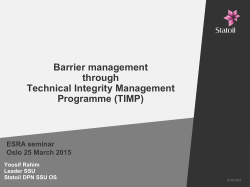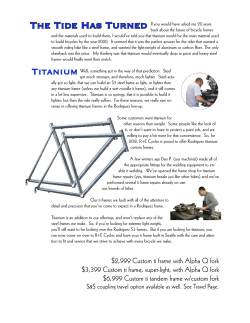
A TD Titanium dioxide
July 2013 TD A TITANIUM DIOXIDE MANUFACTURERS ASSOCIATION for a brighter future Factsheet: Titanium dioxide Forms of titanium dioxide Titanium dioxide (TiO2) is a white solid inorganic substance that is thermally stable, non-flammable, poorly soluble, and not classified as hazardous according to the United Nations’ (UN) Globally Harmonized System of Classification and Labeling of Chemicals (GHS). TiO2 occurs naturally in several kinds of rock and mineral sands. Titanium is the ninth most common element in the earth’s crust. TiO2 is typically thought of as being chemically inert. TiO2 is manufactured in different forms with different properties: Pigment grade TiO2 has primary particles mainly in the size range of 200–350 nm and is not considered a nanomaterial. It has excellent light-scattering properties and is used in applications that require white opacity and brightness. It absorbs UV light. When TiO2 is incorporated in a polymer, it minimises degradation of the system (embrittlement, fading and cracking). TiO2 as a nanomaterial (ultrafine) is engineered to have primary particles less than 100 nm. It appears transparent whilst still providing UV light absorption. Production levels of ultrafine TiO2 comprise only one hundredth of the total TiO2 production. The production processes for pigmentary TiO2 as well as TiO2 as a nanomaterial have not changed significantly over the last three decades. The primary particles in TiO2 are strongly bound or fused together by chemical bonds to form aggregates. They further agglomerate to form particles in the micron size range (μm). Applications Pigment grade titanium dioxide has been used for decades in a vast range of industrial and consumer goods, including paints, coatings, adhesives, paper and paperboard, plastics and rubber, printing inks, coated fabrics and textiles, catalyst systems, ceramics, floor coverings, roofing materials, cosmetics and pharmaceuticals, food colorants, etc. Most of the surfaces and items that are white in colour contain pigmentary TiO2. Certain grades of pigmentary TiO2 which meet appropriate purity standards are approved as a colorant for use in foods (E171, e.g. candies, cookies, sweets, coffee whitener, toothpaste, etc.) and pharmaceuticals (several Pharmacopoeias). Chemistry making a world of difference European Chemical Industry Council – Cefic Avenue E. van Nieuwenhuyse 4 box 1 1160 Brussels - Belgium Tel : +32 2 676 72 11 Fax: +32 2 676 73 01 mail@cefic.be www.cefic.org Responsible Care ® OUR COMMITMENT TO SUSTAINABILITY Select grades of TiO2 in both pigmentary and ultrafine forms are used in cosmetics applications, e.g. in lipsticks, make-up products. Pigmentary TiO2 is used to provide opacity and brightness e.g. in sunscreens Ultrafine TiO2 is used to provide transparency and UV absorbance as the protective ingredient in sunscreens. It contributes to high sun protection factors (SPF) and has been used for many years to provide protection from the harmful ultraviolet radiation from the sun. Ultrafine TiO2 has been used since the 1950s to reduce the environmental emissions of nitrogen oxides. It is used in “Selective Catalytic Reduction (SCR)” systems that convert nitrogen oxides into harmless nitrogen and water. Commercial SCR systems are typically installed in large industrial boilers, combustion plants and stationary or automotive diesel engines. Another application uses the photocatalytic properties of ultrafine TiO2 to provide self-cleaning surfaces e.g. on glass and cement. Use scenarios Safety assessment Occupational exposure: Since the introduction of TiO2 as a commercial product in 1923, there have been no identified health concerns associated with its exposure among consumers or the general population. The product has been proven as safe in its intended uses over many decades. Workers at titanium dioxide manufacturing plants and downstream users can be exposed to TiO2 dust. Protection measures, including engineering controls and personal protective equipment, are applied for exposure control and worker risk mitigation in accordance with existing regulations. Key findings from scientific studies: Four large epidemiology studies involving more than 20,000 workers in the titanium dioxide manufacturing industry in North America and Europe indicate no association with an increased risk of cancer or with any other adverse lung effects.1,2,3,4,5,6 These studies did not specifically differentiate between the ultrafine and pigmentary TiO2. In 2006, the International Agency for Research on Cancer (IARC) evaluated TiO2 as “possibly carcinogenic to humans” (Group 2B) based primarily on studies in rats. However, it is generally recognized that the rat is uniquely sensitive to the effects of “lung overload” which is not observed in other species, including humans. It has been conclusively demonstrated that TiO2, at a concentration of up to 25%, is safe for use in sunscreen products to protect skin from harmful effects of solar UV radiation. Studies show that TiO2 particles (pigmentary or ultrafine) do not penetrate either intact or damaged skin.7,8,9,10 References 1 Boffetta P, Gaborieau V, Nadon L, Parent M-E, Weiderpass E, Siemiatycki J. (2001). Exposure to titanium dioxide and risk of lung cancer in a population-based study from Montreal. Scand. J. Work Environ. Health 27:227-232. 2 Boffetta P., Soutar A., Cherrie J., Granath F., Andersen A., Anttila A., Blettner M., Gaborieau V., Klug S., Langard S., Luce D., Merletti F., Miller B., Mirabelli D., Pukkala E., Adami H-O., and Weiderpass E. (2004). Mortality among workers employed in the titanium dioxide industry in Europe. Cancer Causes and Control 15(7):697-706. 3 Chen J, and Fayerweather W. (1988). Epidemiologic study of workers exposed to titanium dioxide. J. Occup. Med. 30(12):937-42. 4 Fryzek J, Chadda B, Marano D, White K, Schweitzer S, McLaughlin J, and Blot W. (2003). A cohort mortality study among titanium dioxide manufacturing workers in the United States. J. Occup. Environ. Med. 45(4):400-09. 5 Garabrant D.H., Fine L.J., Oliver C., Bernstein L., and Peters J.M. (1987). Abnormalities of pulmonary function and pleural disease among titanium metal production workers. Scand. J. Work Environ. Health 13(1):47-51. 6 Ramanakumar AV, Parent ME, Latreille B, Siemiatycki J. (2008). Risk of lung cancer following exposure to carbon black, titanium dioxide and talc: results from two case-control studies in Montreal. Int J Cancer 122:183-9. 7 Gamer, A. O.; et al. (2006). The in vitro absorption of microfine zinc oxide and titanium dioxide through porcine skin. Toxicology in Vitro 20, 301-307. 8 Mavon, A.; et al. (2007). In vitro percutaneous absorption and in vivo stratum corneum distribution of an organic and a mineral sunscreen. Skin Pharmacol. Physiol. 20, 10-20. 9 Monteiro-Riviere NA.; et al (2011). Safety evaluation of sunscreen formulations containing Titanium Dioxide and Zinc Oxide nanoparticles in UV-B sunburned skin: An in vitro and in vivo study. Toxicological Sciences, 123, 264-280. 10 Schilling, K.; et al. (2010). Human safety review of “nano” titanium dioxide and zinc oxide. Photochem. Photobiol. Sci. 9:495-509. Consumer exposure: Consumer exposure to TiO2 dust by inhalation will be very low because TiO2 is typically incorporated into a product matrix where it is tightly bound, such as in paints or plastics. Oral intake of select grades of pigmentary TiO2 is approved and occurs in the case of food and pharmaceuticals. Skin contact in cosmetics applications is also approved and is a longstanding practice. Environmnetal fate: In many product applications, TiO2 offers downstream environmental benefits (e.g. photocatalysts to decompose pollutants). In cradle-to-grave footprint analyses, both the upstream footprint of manufacture of TiO2 and the downstream environmental performance benefits should be considered. Since TiO2 is inert, non-hazardous and occurs naturally in rocks and minerals, eventual release back to the environment should not be a major concern. Contact Paul Anselme, Titanium Dioxide Manufacturers Association (TDMA), pan@cefic.be
© Copyright 2025





















